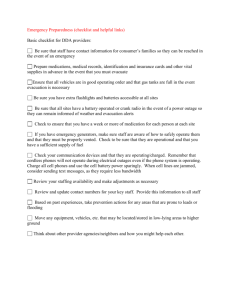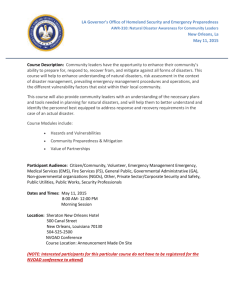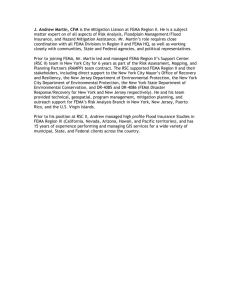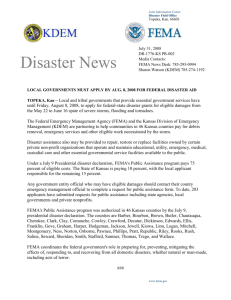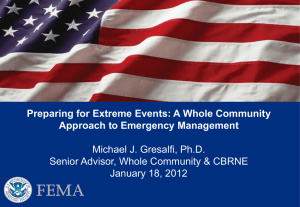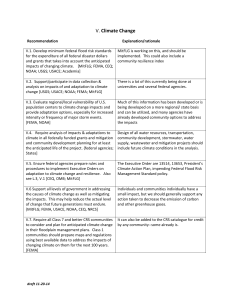Microsoft Word
advertisement
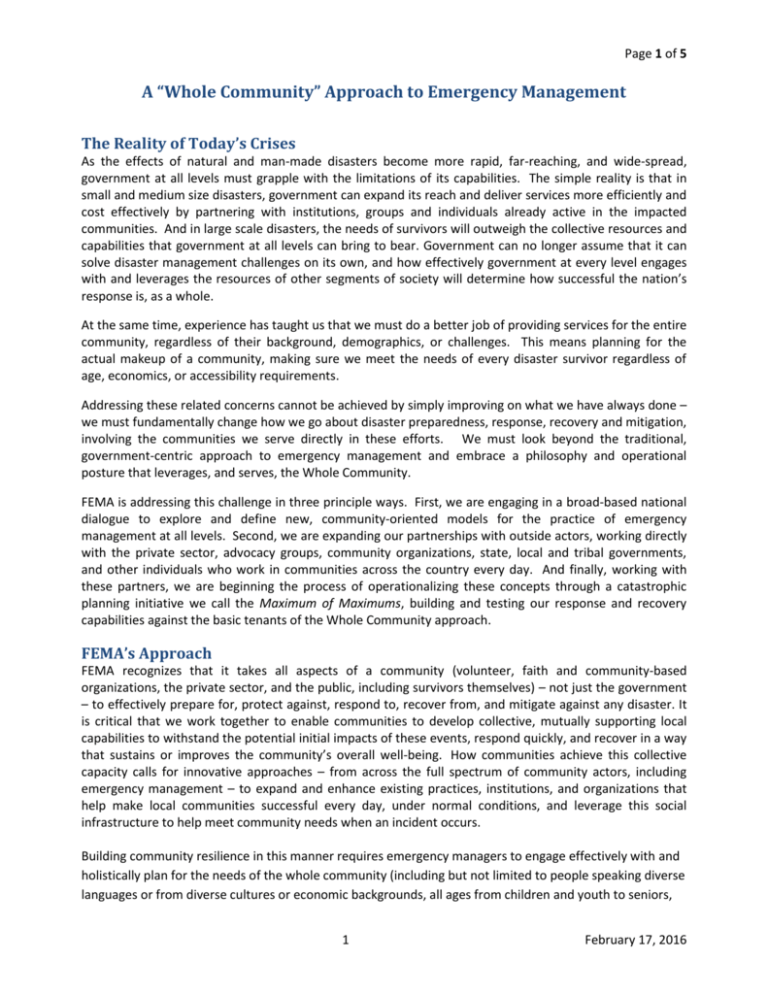
Page 1 of 5 A “Whole Community” Approach to Emergency Management The Reality of Today’s Crises As the effects of natural and man-made disasters become more rapid, far-reaching, and wide-spread, government at all levels must grapple with the limitations of its capabilities. The simple reality is that in small and medium size disasters, government can expand its reach and deliver services more efficiently and cost effectively by partnering with institutions, groups and individuals already active in the impacted communities. And in large scale disasters, the needs of survivors will outweigh the collective resources and capabilities that government at all levels can bring to bear. Government can no longer assume that it can solve disaster management challenges on its own, and how effectively government at every level engages with and leverages the resources of other segments of society will determine how successful the nation’s response is, as a whole. At the same time, experience has taught us that we must do a better job of providing services for the entire community, regardless of their background, demographics, or challenges. This means planning for the actual makeup of a community, making sure we meet the needs of every disaster survivor regardless of age, economics, or accessibility requirements. Addressing these related concerns cannot be achieved by simply improving on what we have always done – we must fundamentally change how we go about disaster preparedness, response, recovery and mitigation, involving the communities we serve directly in these efforts. We must look beyond the traditional, government-centric approach to emergency management and embrace a philosophy and operational posture that leverages, and serves, the Whole Community. FEMA is addressing this challenge in three principle ways. First, we are engaging in a broad-based national dialogue to explore and define new, community-oriented models for the practice of emergency management at all levels. Second, we are expanding our partnerships with outside actors, working directly with the private sector, advocacy groups, community organizations, state, local and tribal governments, and other individuals who work in communities across the country every day. And finally, working with these partners, we are beginning the process of operationalizing these concepts through a catastrophic planning initiative we call the Maximum of Maximums, building and testing our response and recovery capabilities against the basic tenants of the Whole Community approach. FEMA’s Approach FEMA recognizes that it takes all aspects of a community (volunteer, faith and community-based organizations, the private sector, and the public, including survivors themselves) – not just the government – to effectively prepare for, protect against, respond to, recover from, and mitigate against any disaster. It is critical that we work together to enable communities to develop collective, mutually supporting local capabilities to withstand the potential initial impacts of these events, respond quickly, and recover in a way that sustains or improves the community’s overall well-being. How communities achieve this collective capacity calls for innovative approaches – from across the full spectrum of community actors, including emergency management – to expand and enhance existing practices, institutions, and organizations that help make local communities successful every day, under normal conditions, and leverage this social infrastructure to help meet community needs when an incident occurs. Building community resilience in this manner requires emergency managers to engage effectively with and holistically plan for the needs of the whole community (including but not limited to people speaking diverse languages or from diverse cultures or economic backgrounds, all ages from children and youth to seniors, 1 February 17, 2016 Page 2 of 5 people with disabilities, others with access and functional needs, and populations traditional underrepresented in civic governance), realign emergency management practices to support local needs, and work to strengthen the institutions, assets, and networks that work well in communities on a daily basis. We can do this by greatly expanding the traditional emergency management team to include the full fabric of the community, increasing the capacity of all team members, broadening participation in all aspects of emergency management (preparedness, protection, response, recovery, and mitigation), and strengthening underlying economic, social, and environmental conditions. A Whole Community approach to emergency management encompasses three key concepts: o Understanding and meeting the true needs of the entire affected community. o Engaging all aspects of the community (public, private, and civic) in both defining those needs and devising ways to meet them. o Strengthening the assets, institutions, and social processes that work well in communities on a daily basis to improve resilience and emergency management outcomes. Creating a National Dialogue As a key part of its approach, FEMA is conducting an outreach campaign with communities around the country to solicit input, and ideas on how to encourage sustained community participation and involvement in preparedness and resilience activities – both at the local and national levels. This effort involves workshops and listening sessions in which discussions are focused on how communities are motivated and engaged, how they understand risk, and their experiences with resilience following a disaster. o To date, FEMA has engaged a wide range of people and organizations from various geographic, ethnic and professional backgrounds, including the National Youth Summit, FEMA’s Disability Conference, Citizen Corps Roundtable, Center for Homeland Defense and Security, FEMA’s Latino Leadership Conference, National Emergency Management Association, and International Association of Emergency Managers, among other groups. In addition, FEMA has participated in locally lead community discussions in the District of Columbia. o FEMA is co-leading a Multi-National Community Resilience Policy Group with Australia, Canada, the Netherlands, Sweden, and the United Kingdom to explore how governments can better engage with the public to increase locally-organized disaster resilience and empower citizens and local institutions to take an active role in protecting themselves and their communities. The group’s participants are examining case studies of how communities in different countries have prepared for, adapted to, and recovered from a crisis. They are using these cases to identify comparative themes that may inform national policies and programs. o In the near future FEMA will broadly distribute discussion papers that synthesize what it has learned from these domestic and international discussions, and begin to articulate key themes, principles, and potential strategies for the practice of Whole Community Emergency Management. Working with New Partners to Better Prepare Central to the Whole Community approach is the idea of expanding the Emergency Management team, working with groups outside of the federal family to better understand and plan for the needs of a community before, during and after a disaster strikes. To accomplish this goal, FEMA has been aggressively increasing its overall outreach efforts, establishing relationships with new partners and reinvigorating and reframing relationships with the more traditional members of the team. 2 February 17, 2016 Page 3 of 5 o Through its Ready Campaign and associated efforts, FEMA is working to make sure that all Americans have the information they need to be prepared. The Ready Campaign encourages Americans to take simple steps to prepare for emergencies in their homes, businesses, and communities, leveraging New Media, tools, planned events, PSAs, and partnerships with 1000s of coalition members to communicate with the American people. o To successfully strengthened FEMA’s partnerships and increase outreach 10 new regional positions were created to specifically focus on stakeholder engagement in the tribal, private sector and associations’ area. These additional positions will allow FEMA to further their direct reach into these communities at the local level. o In order to promote greater operational coordination with the private sector, FEMA has placed a private sector representative to staff a seat in the National Response Coordination Center. The position is staffed on a rotational basis by a private sector representative with 12 other organizations lined up for future three-month rotations. o FEMA continues to work to engage traditionally underserved communities to better include them in the nation’s emergency management team. FEMA recently hosted leaders from the African American and Latino communities, bringing together leaders from these communities and FEMA representatives to discuss common concerns and challenges. o Working through its Office of Disability Integration and Coordination, FEMA collaborated with federal partners and the American Red Cross to host the first “Getting Real” Emergency Management National Capacity Building Training Conference, bringing together the disability and emergency management communities to better build national capacity for inclusive emergency management practices. In addition, the FEMA Disability Working Group has worked to establish ongoing communications with hundreds of stakeholder groups across the country to ensure people with disabilities are included throughout all levels of emergency management. o This past year FEMA also co-led the National Summit on Youth Preparedness in partnership with the Department of Education and the American Red Cross, bringing together experts in the field of youth communications, programs serving youth, developers of youth preparedness education, practitioners from the state, tribal, and local levels, and academia to design a framework for a national strategy on youth preparedness education. FEMA’s Children’s Working Group also continues to lead efforts to ensure that the needs of children are addressed and integrated into all disaster planning, preparedness, response and recovery efforts. o FEMA has also dedicated expanded resources to these ongoing outreach efforts, establishing new positions at the regional and national level to focus on private sector outreach, tribal and other intergovernmental efforts, disability coordination and integration, and social media. FEMA has also expanded its use of digital channels to engage stakeholders by creating platforms for open dialogue and ongoing conversations, including the FEMA blog, joint partner facebook pages, FEMA’s twitter presence and FEMA mobile website (m.fema.gov). Reshaping Planning and Preparedness Being prepared as a nation means moving beyond a federal or “government-centric” approach to emergency management. As a team, we need to implement solutions that serve the entire community while also leveraging the resources that the entire community brings to the table. But how do we implement this Whole Community concept into the work that FEMA and our partners do every day? FEMA 3 February 17, 2016 Page 4 of 5 has begun driving this concept into its operations, starting with a catastrophic planning initiative known as the Maximum of Maximums: planning and preparing for a catastrophe where extraordinary levels of mass casualties, damage, and disruption overwhelm our traditional, and well established, response and recovery plans and procedures. o FEMA and our partners have analyzed major catastrophes and risk models to create an illustrative set of impacts that are reasonably representative of a large-scale, near simultaneous catastrophes. These impacts serve as a bounding “meta-scenario” against which to plan. We are harnessing the capabilities of our Federal interagency partners through the Emergency Support Function Leadership Group (ESFLG), which has established a formal working group structure to address 13 “core capabilities” associated with almost all large disasters and outcomes essential to both save and sustain lives and stabilize a catastrophic incident of this scale within 72 hours. Both the scale and scope of this meta-disaster scenario present us with a set of response and recovery challenges well beyond any disaster our nation has yet faced. o Instead of using traditional planning methods, we are approaching the problem through a Whole Community lens—planning alongside our partners to ensure that response and recovery activities meet the need of the entire population while bringing the full resources of the private sector, nongovernmental organizations, as well as the public, to bear. Much of what we learn through this process will be applicable to disasters of any size, as the core capabilities are scalable to different communities and the threats and risks they face. Eventually we will re-examine every aspect of our mission and align all of our activities within the context of the whole community approach. o Along with our interagency partners, FEMA has established thirteen teams – comprised of federal employees, representatives from private industries, the medical and public health, faith-based and civic sectors – to focus on each of the core capabilities. They have been charged with making recommendations about how we can apply the Whole Community approach in tangible ways to develop innovative solutions to the challenges posed by a catastrophic event. We will be testing the ideas, concepts, and solutions that these teams propose through national-level exercises and new planning guidelines, protocols, and official partnerships. These exercises will include the National Level Exercise 2011, which will take place next spring and test our ability to respond if a severe earthquake were to strike the New Madrid Zone of the U.S. o We believe that by engaging a wide range of stakeholders in this process we will be able to explore new ways of doing business and solving problems. Disasters are difficult by nature, and we need out of the box thinking to tackle the challenges we face. As part of this effort, FEMA is initiating an academic outreach campaign to acculturate present and future homeland security and emergency management leaders to this concept, and engage researchers in the development of new solutions. o We are working with the American Red Cross and other members of a team to create a new, interoperable, unified strategy for providing mass care for disaster survivors of a catastrophic event. o We are redeveloping our preparedness activities, including training, exercises, operational plans, and grant programs, to incorporate our Whole Community approach. Though the Whole Community approach will eventually be applied to all of our core missions, this Maximum of Maximums effort is an important first step in making concrete changes in the way we conduct our operations. 4 February 17, 2016 Page 5 of 5 Getting Involved Through the activities discussed above, FEMA seeks to spark dramatic expansion and transformation of current community engagement strategies to promote approaches that position local residents in leadership roles in planning, organizing, and sharing accountability for the success of local disaster management efforts. We believe that Whole Community Emergency Management is a philosophy that should be applied to everything we do, as an agency, and as a field of practice. To that end, FEMA will support the development of guidance, tools, training, and educational programs that effectively engage and integrate the entire community into local emergency management activities to strengthen resilience and improve outcomes. This is just a start. It will take time to transform the way the emergency management team thinks about, plans for, and responds to disasters. But we can’t afford to wait. FEMA recognizes that the world we live in, the challenges we face and the communities we serve are constantly evolving, and as an agency we will always need to adapt, often at a moment’s notice. We know that this change in the nation’s fundamental approach to addressing the needs of survivors is vital to our goal of keeping the people and communities we serve safe and doing our best to prevent the loss of life and property when disasters strike. For more information contact: FEMA-Community-Engagement@dhs.gov C:\Documents and Settings\June\My Documents\_C-CalEMA Course\Parts\02 Introduction\Whole Community Approach to Emergency Management Overview.final.012411.doc 5 February 17, 2016

